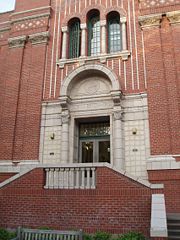
Lillis Business Complex
Encyclopedia

University of Oregon
-Colleges and schools:The University of Oregon is organized into eight schools and colleges—six professional schools and colleges, an Arts and Sciences College and an Honors College.- School of Architecture and Allied Arts :...
campus
University of Oregon campus
The campus of the University of Oregon is located in Eugene, Oregon and includes some 80 buildings and facilities, including athletics facilities such as Hayward Field, which was the site of the 2008 Olympic Track and Field Trials, and McArthur Court, and off-campus sites such as nearby Autzen...
in Eugene
Eugene, Oregon
Eugene is the second largest city in the U.S. state of Oregon and the seat of Lane County. It is located at the south end of the Willamette Valley, at the confluence of the McKenzie and Willamette rivers, about east of the Oregon Coast.As of the 2010 U.S...
, Oregon
Oregon
Oregon is a state in the Pacific Northwest region of the United States. It is located on the Pacific coast, with Washington to the north, California to the south, Nevada on the southeast and Idaho to the east. The Columbia and Snake rivers delineate much of Oregon's northern and eastern...
. It is home to the Charles H. Lundquist College of Business, and comprises the new main building (called Lillis Hall), completed in 2003, as well as three older buildings, Gilbert Hall, Peterson Hall, and the Chiles Business Center.
History

Ellis F. Lawrence
Ellis Fuller Lawrence was an American architect who worked primarily in the U.S. state of Oregon. In 1914, he helped found and was the first dean of the University of Oregon's School of Architecture and Allied Arts, a position he held until his death.Lawrence concurrently served as campus...
, and were designed to serve as "entry pylons" for the main campus quadrangle (now called the Memorial Quadrangle).
Commonwealth Hall opened in 1952, and connected Oregon Hall (formerly Education) and Commerce. In 1975, Commonwealth Hall was renamed after James H. Gilbert, and Education was renamed Gilbert West, while Commerce became Gilbert East.
The Chiles Business Center was completed (adjacent to the Gilberts) in 1986 to accommodate the expanding Lundquist College of Business. In 2001, Gilbert Hall (the former Commonwealth) was demolished to make way for construction of the Lillis Business Complex. At this time, Gilbert West (formerly Oregon Hall and Education) was renamed Peterson Hall, and Gilbert East took the name Gilbert Hall.
The 2003 construction of the Lillis Business Complex resulted in the linking of all three existing buildings with the new Lillis "backbone." In addition, Lillis Hall contains numerous faculty offices, classrooms, a lecture hall, and an auditorium.
Architecture

Solar cell
A solar cell is a solid state electrical device that converts the energy of light directly into electricity by the photovoltaic effect....
embedded in the glass, which provide a portion of the building's energy. In addition, the building, classrooms, and offices were oriented so as to maximize the use of natural light, and all rooms are outfitted with the latest sensor technology to minimize energy usage.
Awards
In 2005, the building received the U.S. Green Building Council's LEEDLeadership in Energy and Environmental Design
Leadership in Energy and Environmental Design consists of a suite of rating systems for the design, construction and operation of high performance green buildings, homes and neighborhoods....
-NC Silver designation, ranking it higher than any other business school in the nation. Additionally, it is among the most environmentally conscious buildings on any college campus in the U.S.
United States
The United States of America is a federal constitutional republic comprising fifty states and a federal district...
.

Renovation
Peterson and Gilbert Halls have been declared historic buildings, and they are scheduled to be internally renovated under LEED-EB (for Existing Building) standards in early 2007 with Peterson currently undergoing renovation."Wind Fence"
"Wind Fence" is a sculptureSculpture
Sculpture is three-dimensional artwork created by shaping or combining hard materials—typically stone such as marble—or metal, glass, or wood. Softer materials can also be used, such as clay, textiles, plastics, polymers and softer metals...
designed for and installed on the north side of the Lillis Business Complex by artist Ned Kahn
Ned Kahn
Ned Kahn is an environmental artist and sculptor, famous in particular for museum exhibits he has built for the Exploratorium in San Francisco...
. It is composed of panels of small aluminum flaps, suspended in the air, which are allowed to freely move in the wind. The design reveals the invisible passage of wind through the fence. It was funded by the State of Oregon
Oregon
Oregon is a state in the Pacific Northwest region of the United States. It is located on the Pacific coast, with Washington to the north, California to the south, Nevada on the southeast and Idaho to the east. The Columbia and Snake rivers delineate much of Oregon's northern and eastern...
as part of the statewide Percent for Art
Percent for Art
The term "percent for art" refers to a program, often a city ordinance, where a fee, usually some percentage of the project cost, is placed on large scale development projects in order to fund and install public art. The details of such programs vary from area-to-area...
program.

